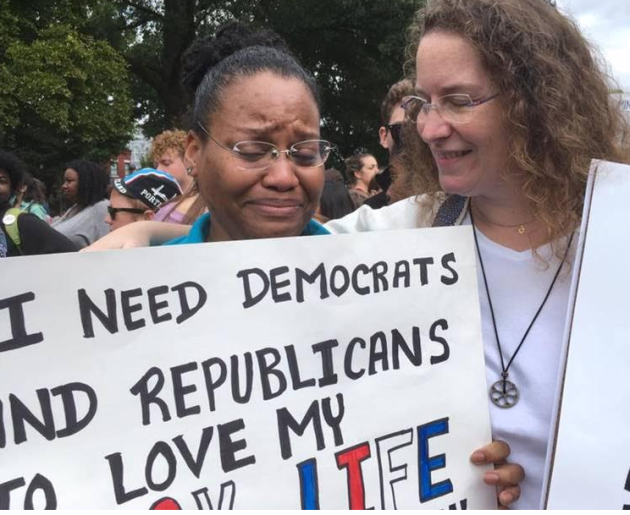
Marching for Racial Justice on Yom Kippur
My primary intersectional identity as an adult has been as Jewish, female, and upper middle class. I gave very little thought to how much privilege flows to me as a white person.
Two examples come to mind. We bought a huge, beautiful home in Mt. Airy, an integrated neighborhood in Philadelphia, in 1986. We could afford so much house because the neighborhood is integrated. This lowered property values. Comparable homes in the whiter suburbs were way costlier, as were the property taxes to pay for their great schools. Racism lowered our overhead.
Why were we willing to move to a neighborhood with crappy schools? Because we sent our kids to Jewish Day School. We did so because we wanted our kids to have a solid Jewish education but, de facto, it allowed us to ignore our city’s struggling public (majority poor and black) school system.
Benefiting from racism is not the same as being racist, of course, but we ask forgiveness for acts both conscious and those performed unwittingly. Marching for racial justice doesn’t repair past damage. But it is at least a modest act of public atonement.
The march was wonderfully positive, a glorious sunny day of white people and black people collectively denouncing injustice and vowing to do better.

Photo credit: Marjie Hashmall George. Left: Regina Marie Foertsch, right Lynna Schaefer.
Lynna Schaefer and I met on the M4RJ listserv when I invited Jews who wanted to observe Yom Kippur at the march to join me. She created a beautiful, highly visible sign “Justice Justice Shall You Pursue” sign and brought it all the way from Albany. We arranged to meet at the march, dressed for Yom Kippur in white clothing, kippot, and tallitot. We were a magnet for a tribe of other Jewish marchers—rabbis, secular Jews, congregants from the D.C .area, and Jewish students. I was even interviewed by Rachel Chason of the Washington Post.
“I find marching is a very sacred experience,” said Teutsch, of Philadelphia. “You’re with a large collective. This is a chance to express Yom Kippur in a different way.”
Fellow marchers thanked us for coming and wished us a Happy New Year. We felt very supported and respected. But the moment that brought the whole day home was when Regina Marie Foertsch, a middle-aged African American, reacted to seeing us dressed for synagogue. “You came on Yom Kippur!” she gasped. “I can’t believe it!” After taking it in, she began to weep. She and Lynna embraced; my fellow marchers and I felt the full power of the simple act of our showing up.
*A beautiful apology from the march’s organizers to the Jewish community can be found here.
The views and opinions expressed in this article are the author’s own and do not necessarily reflect those of Lilith Magazine.
One comment on “Marching for Racial Justice on Yom Kippur”
Comments are closed.




I, too, chose to pray with my feet and attend our community’s Pride parade. It was the right decision for our family.